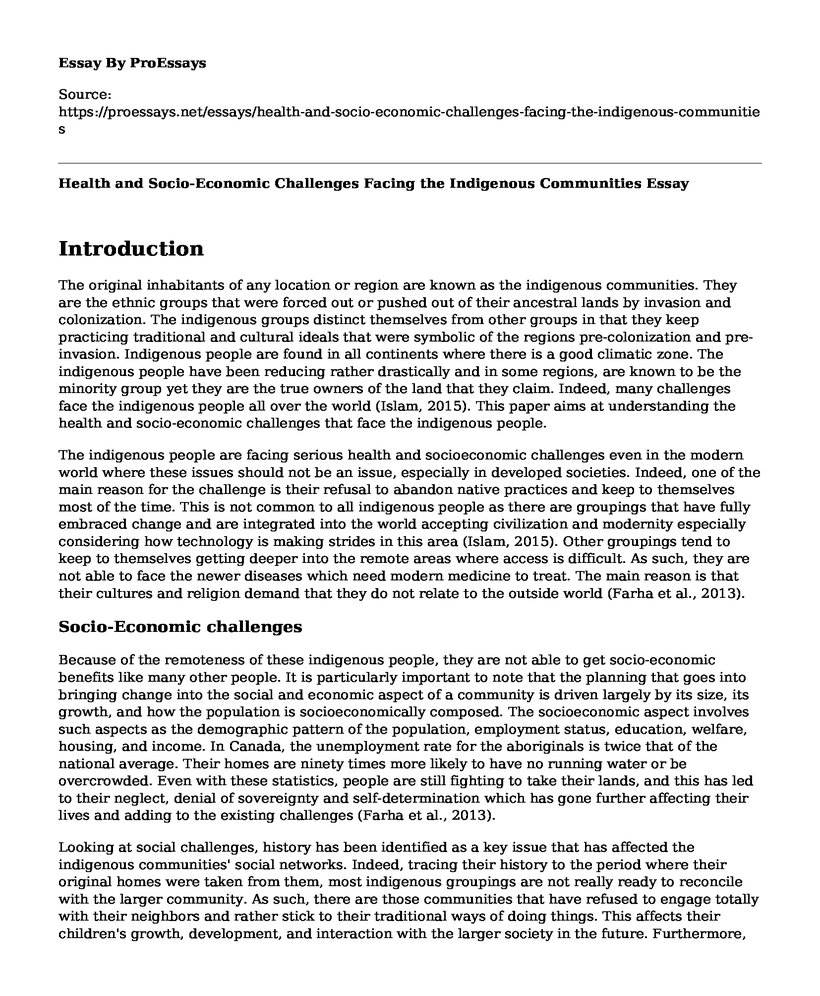Introduction
The original inhabitants of any location or region are known as the indigenous communities. They are the ethnic groups that were forced out or pushed out of their ancestral lands by invasion and colonization. The indigenous groups distinct themselves from other groups in that they keep practicing traditional and cultural ideals that were symbolic of the regions pre-colonization and pre-invasion. Indigenous people are found in all continents where there is a good climatic zone. The indigenous people have been reducing rather drastically and in some regions, are known to be the minority group yet they are the true owners of the land that they claim. Indeed, many challenges face the indigenous people all over the world (Islam, 2015). This paper aims at understanding the health and socio-economic challenges that face the indigenous people.
The indigenous people are facing serious health and socioeconomic challenges even in the modern world where these issues should not be an issue, especially in developed societies. Indeed, one of the main reason for the challenge is their refusal to abandon native practices and keep to themselves most of the time. This is not common to all indigenous people as there are groupings that have fully embraced change and are integrated into the world accepting civilization and modernity especially considering how technology is making strides in this area (Islam, 2015). Other groupings tend to keep to themselves getting deeper into the remote areas where access is difficult. As such, they are not able to face the newer diseases which need modern medicine to treat. The main reason is that their cultures and religion demand that they do not relate to the outside world (Farha et al., 2013).
Socio-Economic challenges
Because of the remoteness of these indigenous people, they are not able to get socio-economic benefits like many other people. It is particularly important to note that the planning that goes into bringing change into the social and economic aspect of a community is driven largely by its size, its growth, and how the population is socioeconomically composed. The socioeconomic aspect involves such aspects as the demographic pattern of the population, employment status, education, welfare, housing, and income. In Canada, the unemployment rate for the aboriginals is twice that of the national average. Their homes are ninety times more likely to have no running water or be overcrowded. Even with these statistics, people are still fighting to take their lands, and this has led to their neglect, denial of sovereignty and self-determination which has gone further affecting their lives and adding to the existing challenges (Farha et al., 2013).
Looking at social challenges, history has been identified as a key issue that has affected the indigenous communities' social networks. Indeed, tracing their history to the period where their original homes were taken from them, most indigenous groupings are not really ready to reconcile with the larger community. As such, there are those communities that have refused to engage totally with their neighbors and rather stick to their traditional ways of doing things. This affects their children's growth, development, and interaction with the larger society in the future. Furthermore, they are also not ready to go to school for fear that it will water down their traditions and it is some form of disrespect to their ancestors. This has affected their education levels, and it is a known fact that the indigenous communities form a huge chunk of the most illiterate groupings all over the world (Islam, 2015).
Because they lack proper education, they cannot get proper employment and even though most indigenous people have moved to cities and towns looking for work, they can only get minimum wage type of jobs. This goes further to affect their income levels, their welfare as well as housing. Economically, the indigenous people are struggling because they realize that they cannot get enough from what they used to do in the past such as hunting, gathering, as well as small-scale farms. These challenges are forcing them to look for employment to boost their economic wellbeing which is also becoming hard to come by (Islam, 2015).
References
Farha, L., Rothman, L., Morbia, R., Day, S., & Frasier, J. (2013, February 5). Anti-poverty and human rights groups shoulder-to-shoulder with Idle No More | The Star. Retrieved from https://www.thestar.com/opinion/editorialopinion/2013/02/05/anti_poverty_and_human_rights_groups_shouldertoshoulder_with_idle_no_more.html
Heritage BC. (n.d.). First Peoples? Heritage - Heritage BC. Retrieved from https://heritagebc.ca/resources/first-peoples-heritage/Islam, M. S. (2015). Ethnic Organization and Alternative Development: Possibilities and Challenges. Pursuing Alternative Development: Indigenous People, Ethnic Organization and Agency, 113-126
Cite this page
Health and Socio-Economic Challenges Facing the Indigenous Communities. (2022, Sep 22). Retrieved from https://proessays.net/essays/health-and-socio-economic-challenges-facing-the-indigenous-communities
If you are the original author of this essay and no longer wish to have it published on the ProEssays website, please click below to request its removal:
- Investigating Infectious Diseases in Hospital Settings. Paper Example.
- Research Proposal Sample: Whether Minority SMEs Have the Same Access to Loans Compared to Their White Counterparts
- The Nature and Evidence of Gender Pay Gap Essay Example
- Workplace and Leadership Perceptions Between Men and Women Essay Example
- Essay Sample on Childhood Obesity in United States
- Unemployment: Causes, Implications and Solutions - Essay Sample
- Essay Example on Gender Inequality in the Workplace: Examining HR as the Source







